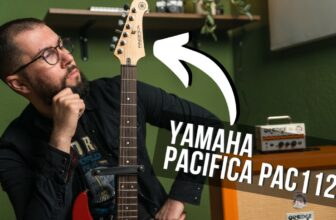The Ultimate Guide to Buying Your First Guitar (2024)
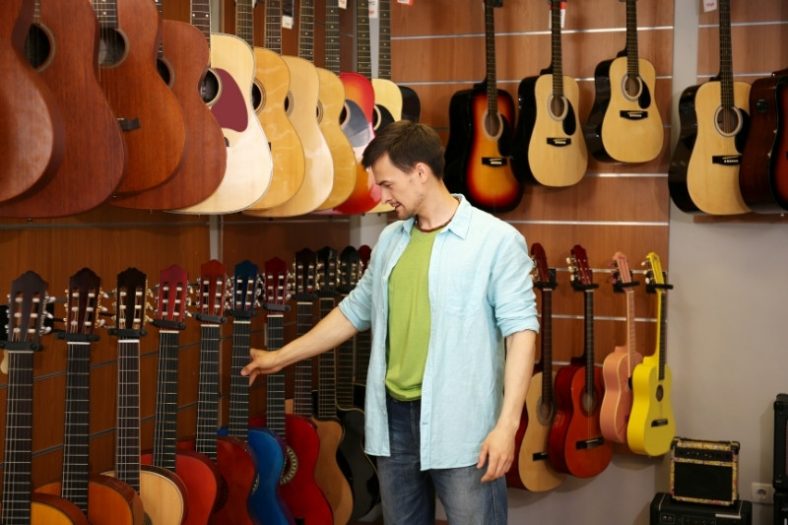
Buying your first guitar is a long-term investment. Many factors come into play when purchasing your first guitar like the type, size, quality, and sound. You should consider your goal as well. If you’re a hobbyist or trying to pursue a career in music, your first guitar is special.
The reason why your first guitar is special is that it will make or break your musical journey. Choosing the right type, size, looks, quality, and sound will play a vital role in your daily life. It’s important to pick a good starting guitar not only for the quality but also for the design. The design is what triggers you to pick it up and start practicing.
This guide will aid in your choice while also advising on crucial elements and key features to keep an eye out for. Let’s dive in!
Contents
Things to Consider Before Buying your First Guitar
A few things to keep in mind when purchasing your first guitar are the type, size, necessary gear, and the quality of the guitar. It’s also worth thinking about whether you want a new or used guitar.
1. Acoustic or Electric Guitar
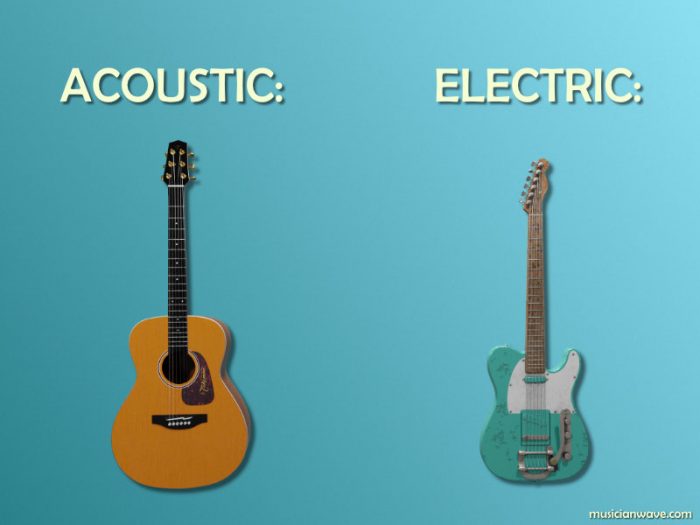
When choosing between the two types, it’s important to know that acoustic guitars are better suited for beginners. Electric guitars are more versatile and play a bigger role long-term.
The acoustic guitar, preferably with nylon strings, is the ideal choice for a beginner because of the playability, strings, and no-frills design. It helps beginner guitarists successfully build their foundation without getting carried away with flashy effects and design.
An electric guitar is a more long-term investment because eventually, you will transition to one. It is way more versatile but requires a higher investment due to the accompanying accessories like an amp, cable, and so on.
Advantages and Disadvantages
Acoustic Guitar
| Pros | Cons |
| Affordable | Lacks versatility |
| Better for beginners overall | More fragile |
| Nylon strings to easy playing | Wider fretboard |
| No-frills design |
Electric Guitar
| Pros | Cons |
| Versatile | Requires more investment (amp, cable, etc.) |
| Good build quality | Can be confusing for beginners |
| Thin neck | Requires tone-shaping |
| Low-volume practice |
2. The Size of the Guitar
Depending on your age and height, different sizes may be more suitable for you. There are mini-guitars, 3/4-sized guitars, and full-sized ones. If you’re a kid or a small teen, a smaller guitar will provide you with the necessary playability and overall balance of the instrument. Naturally, if you’re taller, a full-sized guitar is optimal.
| Mini-Guitars | 3/4 Guitars | Full-Sized Guitars |
| Suitable for kids, small teens | Moderate size | Full size |
| Shorter neck | No full-size neck-length | Average neck length |
| Small body | Compact body | Normal body design |
Scale-length
Scale-length is what encompasses the size of the guitar. It is the distance between the nut and bridge on the guitar. Check out Guitar Part Names for a more detailed insight.
Mini-guitars and 3/4 guitars can average a scale length between 20” and 24”. This is considered a smaller guitar that is much better suited for kids and small teens. Full-sized guitars, however, have an average scale-length of 24-26”. Just as an example, a bass guitar has a scale-length of 34”.
Scale-length determines how far you will have to reach for the frets. Playability is compromised if you choose to go for a bigger guitar so consider your size and age before choosing the right one.
3. New Guitar or Used/Second-Hand
There is no right or wrong on this topic. But, a few things come into play before deciding on whether you want a new guitar or settle for a used/second-hand one. Before discussing the advantages and disadvantages, it’s important to mention that there are very good quality second-hand guitars out there.
Advantages and Disadvantages
New Guitar
| Pros | Cons |
| A brand new product, the first owner | A bit more pricey |
| Quality is intact | Long-term investment (disadvantage if you’re just a hobbyist) |
| Good sound quality | |
| Safe investment |
Used/Second Hand Guitar
| Pros | Cons |
| Battle-tested | No peak quality |
| Vintage looks | The sound may be compromised |
| Short-term investment | Never 100% sure about the product |
| More affordable |
It all boils down to preference. The best advice here is to consider your goal. If you want something short-term and for fun, go for a used or second-hand guitar. If you are serious about your musical endeavors, a new guitar is always better!
4. Try it for Yourself
The already established notion is that purchasing a guitar is a no-joke investment. The best approach to choosing the right one is to try out the guitar for yourself. Visit your local music store and try a few different ones to get the feel of the playability, size, and price of the guitar.
If you’re looking for a used guitar, also try it out when you can. Visit the second-hand shop or individual that is selling the guitar. Be mindful that you can never be 100% sure about second-hand guitars so try to be thorough as you test the product.
5. Necessary Equipment
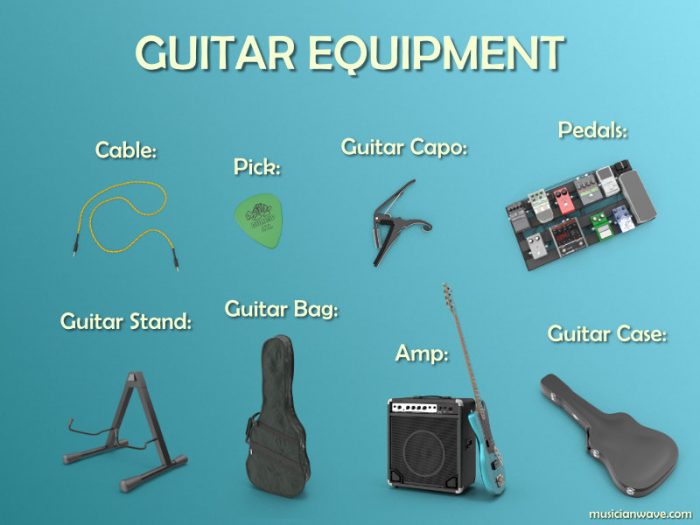
Crucial gear does not only apply to electric guitars. Acoustic guitars still require some investment in equipment like a pick, guitar strap, and extra strings. Electric guitars, naturally, require much more investing as you would need an amp and cable at the very least.
For acoustic guitars, I would advise getting a few picks off the bat as they are easy to misplace or lose. A guitar strap is necessary to learn the proper posture while standing as well as balancing the instrument. And, naturally, extra strings are a must! You don’t want to skip a few practice sessions because one of your strings is missing/broken.
For electric guitars, this investment is more pricey. An electric guitar depends on an amplifier which can be costly and a guitar cable. Of course, if you want more versatility, investing in guitar pedals is another extra cost you should consider.
Whether you’re after an acoustic or electric guitar, a tuner should be your best investment yet. If you have an acoustic guitar, many free tuner apps can do the trick. For electric guitars, however, I urge you to invest in a clip-on tuner, or a tuner pedal as they are more accurate.
6. Quality
When looking for quality products, your best bet is to stick with well-known and more familiar brands. Naturally, if you want quality, the new-vs-old debate is settled as a new guitar is always better. Lastly, think of it as a long-term investment and choose the right one, even if it costs a bit more.
When it comes to brands, it can be hard to pick one over another. For a more detailed insight, check out The 15 Best Acoustic Guitar Brands and make an informative decision. For electric options, you can see The 20 Best Electric Guitar Brands.
Tips for Buying your First Guitar
Tips for buying your first guitar can be divided into three categories that revolve around how much budget you have, short or long-term, and whether or not you’re after a professional career or just a hobby.
- If you lack the budget and you’re still not 100% sure you want to pursue your musical endeavors, take it slow and gradually progress. Buy a used guitar – it’s more affordable. As time goes on, you will be able to figure out if playing the guitar is for you.
- If budget is a non-issue, you should think long-term and invest in a quality product that will stand the test of time. Whether or not you pursue a career or gain a hobby in the process, a quality product will serve you for a long time. Worst case scenario, you can sell the quality product for a good price.
- I strongly advise you to take guitar lessons. If you take the time to invest, not just your money but time, the best way is via lessons. There are great online guitar lesson platforms like Guitareo out there that can help. Private lessons are also a great resource for knowledge and include a more on-hand and narrow experience.
Check out our video review about Guitareo to see it in action.
What is the Best Way to Approach Buying a Guitar?
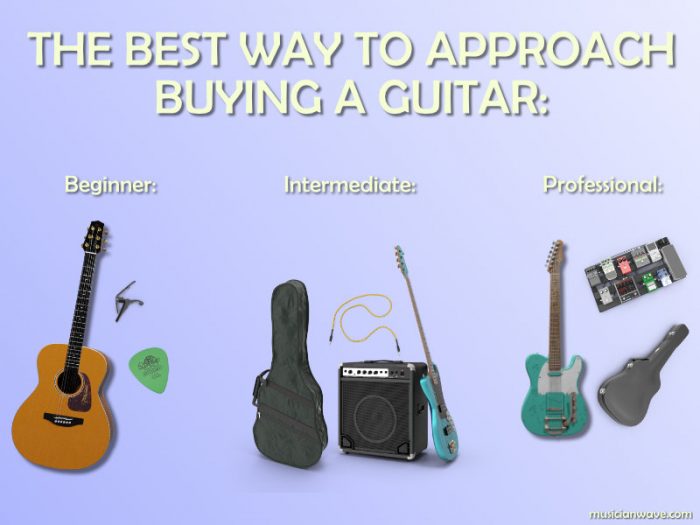
The best way to approach buying a guitar is to invest little, gradually progress, and expand if you’re into it. Many guitar endeavors have fallen short because of moving too fast and discouragement. The first and most important step is to see if you like playing the guitar because without interest there would likely be progress.
Invest in a good affordable or mid-range acoustic guitar. Learn the fundamentals like scales, chords, and holding a note. This will be easily and effectively done via online or private lessons. Try online lessons because they are more affordable.
However, if you really want to, you can go straight to an electric guitar without buying an acoustic one. There are guitar packs available that include everything you need to get started (include an amp and guitar cable).
After a few months or a year, depending on your progress, you should have a good idea of what you want to pursue. Gradually invest and expand your equipment, maybe a more expensive guitar. Electric guitars are the way to go to get that versatility and open your creativity to other types of sounds and genres.
Guitar pedals are some of the best accessories you can focus your budget on. Plus, you get to have more fun experimenting with different effects like reverb, delay, chorus, and similar. You can even recreate some iconic sounds from songs you admire.
What are the most common Guitar Types?
When it comes to guitar types, the ones you will most likely encounter are classical, acoustic, electric, and acoustic-electric guitars.
Classical guitars are characterized by nylon strings. These guitars are most suited for beginner guitar players due to the lack of strong tension on the fingers. Most beginner guitarists will struggle to build up their calluses, but nylon strings are the best way to get a good start.
Acoustic guitars, though very similar to classical guitars, differ in string material. Acoustic guitars use metal strings and require a somewhat base of developed calluses. When you’ve played some time on nylon strings, you can try out metal strings to further develop your calluses while effectively avoiding injuries to your fingers.
Electric guitars are the most popular type of guitars, and like acoustic guitars, they use metal strings. Electric guitars are known for their versatile sound and wide use in almost all genres of music. Nowadays, almost every group will have an electric guitar in their line-up.
Acoustic-electric guitars have gained huge popularity over the years. Their use extends to almost every genre and they are particularly popular with gigging musicians who play covers. This type of guitar has many benefits as it has all the best features of both worlds.
What Wood Material is best to go for?
Guitars can be made from various wood materials but the most common and best wood to go for are maple, mahogany, and rosewood.
Maple
You will find many maple guitars on the market and to no surprise, this is a very popular and good-quality wood type. Maple is good because it embodies a low-resonance nature. This means that your tones will have a good decay rate. It’s a light material but a very popular choice to go for.
| Pros | Cons |
| Great sustain | Suitable for mellow-sounding music |
| Aesthetically pleasing | Lack a bit in the overtone department |
| Light material to ease playing |
Mahogany
Mahogany wood is also extremely popular. It has a subtle mid-range character that also embodies a low-resonance nature. It produces thick sounds that are very much sought after. It’s a top-tier wood material that you can find on the market today.
| Pros | Cons |
| Fairly durable wood | More suited for rock, metal, jazz, and similar styles |
| Thick-sounding nature | Not as clear and crisp sounds as other types |
| Dark tones with low-resonance |
Rosewood
Rosewood, unlike mahogany and maple, has an opposite sound nature – high resonance. With the characteristics of this beautiful wood type, it produces sharp tones while also capturing high and low notes effectively.
| Pros | Cons |
| High-resonance nature | More pricey |
| Produces high and low notes effectively | Strumming sounds a bit too much |
| Unique and appealing looks |
Conclusion
Before you buy a guitar, it’s essential to understand the many sorts of guitars available and the materials they’re composed of. Different woods and materials produce different tones. This is why it’s important to choose something that compliments your style of playing.
With all of this in mind, maple, mahogany, and rosewood are all great choices for a first guitar. Begin by investing a modest amount of cash. As you get more experienced, gradually upgrade your guitar so that it fits your preferences and sounds great.




